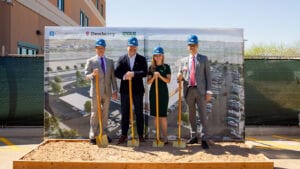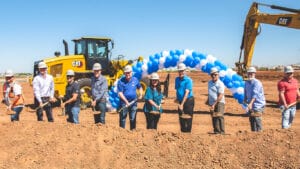Heading into 2017, housing market experts share cautious optimism about the future of Arizona’s residential market, which they discussed in front of a sellout crowd of nearly 700 people at the eighth annual AZ Dealmakers event today.
The theme for this year’s event — put on by Belfiore Real Estate Consulting, Rose Law Group and various sponsors — was “Rebuilding a Leading Housing Market,” which consisted of two panels focusing on the difficulty of buying new lots followed by why and where densities are rising.
Naturally, the conversations also touched on hot-topic issues such as housing supply and demand, rising costs of labor and land, Millennials’ impact, new product types and President-elect Donald Trump.
Helping steer the conversation and direct questions for the first panel was Court Rich, senior partner at Rose Law Group, followed by the second moderator/older sister, Jordan Rose, president and founder of Rose Law Group.

In between the panels, Jim Belfiore, founder and president of Belfiore Real Estate Consulting, delivered a housing market forecast for Phoenix, Tucson and Northern Arizona.
Overall, Arizona’s housing market is good. Steven J. Hilton, chairman, CEO and co-founder of Meritage Homes Corporation, said we still aren’t back to normal. Although, he’s cautiously optimistic about the direction of the market.
Last year, price appreciation rose 2-3 percent and the number of home sales in Arizona hit a three-year high of 1,500-plus homes in July 2016.
Belfiore said, “The challenge builders have now is the same challenge they had in 2015 and 2016 — how to raise margins that have been severely shrunken over the last 24 months.”
Panelists agreed the biggest challenge isn’t demand or supply anymore but rather cost and pricing.
The paradox in the market at the moment revolves around the fact that homebuilders are selling more homes but making less money due to high costs for labor and land.
Adding to the challenge is the skilled labor shortage, which is costing more due to basic supply and demand economics.
In the meantime, builders are exploring ways to attract the nation’s largest generation, the Millennials, into buying their first homes.
The first panel described the generation as “delayed homebuyers,” because the rate they are buying homes is slower than previous generations.
Millennials are also getting married, starting families and having kids later in life. As a result, Millennials may choose to rent in urban environments, but one way developers are pushing back is by lowering price points on entry level housing.
Newer housing product types with higher densities also help create a more urban environment to attract the Millennial homebuyers.
An example the second panel mentioned was the “surban” living concept, which is a hybrid between the sense of community of a suburb with an urban feel.
Many of the big questions still surrounding the housing market involve new President-elect Donald Trump, who’s proposed changes to immigration and regulations create uncertainty as it’s unclear what he will implement.
Time will tell what the future really holds for Arizona’s housing market, but peering into the crystal ball, these homebuilders and land owners are cautiously optimistic about 2017.




